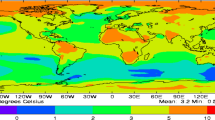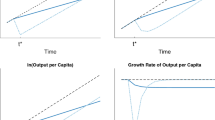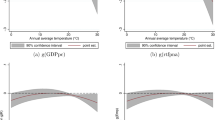Abstract
This paper introduces new data on climatic conditions to empirical tests of growth theories. We find that, since 1960, temperate countries have converged towards high levels of income while tropical nations have converged towards various income levels associated with economic scale and the extent of the market. These results hold for a wide range of tests. A plausible explanation is that temperate regions' growth was assisted by their climate, perhaps historically for their transition out of agriculture into sectors whose productivity converges across countries, while tropical countries' growth is relatively more dependent on gains from specialization and trade.
Similar content being viewed by others
References
Ades, A. F., and E. L. Glaeser. (1999). “Evidence on Growth, Increasing Returns and the Extent of the Market,” Quarterly Journal of Economics 114(3), 1025-1045.
Aristotle (n.d.), The Politics. Benjamin Jowett, trans. (http://classics.mit/edu/Aristotle/politics.html).
Backus, D. K., P. J. Kehoe, and T. J. Kehoe. (1992). “In Search of Scale Effects in Trade and Growth,”, Journal of Economic Theory 58(2), 377-409.
Bailey, R. G. (1989). “Explanatory Supplement to Ecoregions Map of the Continents,” Environmental Conservation 16, 307-309.
Barro, R. J. (1991). “Economic Growth in a Cross Section of Countries,” Quarterly Journal of Economics 106(2), 407-443.
Barro, R. J., and X. Sala-i-Martin. (1992). “Convergence,” Journal of Political Economy 100(2), 223-251.
Belsley, D. A., E. Kuh, and R. E. Welsch. (1980). Regression Diagnostics. New York: Wiley.
Bernard, A. C., and C. I. Jones. (1996). “Comparing Apples to Oranges: Productivity Convergence and Measurement Across Industries and Countries,” American Economic Review 86(5), 1216-1238.
Bloom, D. E., and J. D. Sachs. (1998). “Geography, Demography and Growth in Africa,” Brookings Papers on Economic Activity 2, 207-295.
Easterly, W., and R. Levine (1997). “Africa's Growth Tragedy: Policies and Ethnic Divisions,” Quarterly Journal of Economics 112(4), 1203-1250.
ESRI (1996). ArcAtlas. Redlands, CA: Environmental Systems Research Institute.
Frankel, J. A., and D. Romer (1999). “Does Trade Cause Growth?” American Economic Review 89(3), 379-399.
Fulginiti, L. E., and R. K. Perrin. (1997). “LDC Agriculture: Nonparametric Malmquist Productivity Indexes,” Journal of Development Economics 53, 373-390.
Gallup, J. L., and J. D. Sachs with A. D. Mellinger. (1999). “Geography and Economic Development,” in Annual World Bank Conference on Development Economics 1998, Boris Pleskovic and Joseph E. Stiglitz, eds. Washington, DC: The World Bank (April). Also published in International Regional Science Review 22 (2), 179–232.
Gallup, J. L., and J. Sachs. (1999). “Agriculture Productivity and Geography,” Center for International Development, Harvard University, Mimeo (May).
Gallup, J. L., A. D. Mellinger, and J. D. Sachs. (2000). “Geography GIS files,” http://www.cid.harvard.edu/ciddata/Geog/gisdata.html
Geiger, R., and W. Pohl. (1954). Revision of the Köppen-Geiger Klimakarte der Erde Erdkunde, 8, 58-61.
Hall, R. E., and C. I. Jones. (1999). “Why Do Some Countries Produce so Much More Output per Worker than Others?” Quarterly Journal of Economics 114(1), 83-116.
Hanna, J. M., and D. E. Brown. (1983). “Human Heat Tolerance: An Anthropological Perspective,” Annual Review of Anthropology, 12, 259-284.
Holdridge, L. R. et al. (1971). Forest Environments in Tropical Life Zones: A Pilot Study. New York: Pergamon Press.
International Panel on Climate Change (1999). IPCC Data Distribution Data Centre CD-ROM, April.
Kamarck, A. M. (1976). The Tropics and Economic Development: A Provocative Inquiry into the Poverty of Nations. Baltimore: Johns Hopkins.
Kellman, M., and R. Tackaberry. (1997). Tropical Environments: The Functioning and Management of Tropical Ecosystems. New York: Routledge.
Mankiw, N. G., D. Romer, and D. N. Weil. (1992). “A Contribution to the Empirics of Economic Growth,” Quarterly Journal of Economics 107(2), 407-437.
Matthews, E. (1983). “Global Vegetation and Land Use: New High Resolution Data Bases for Climate Studies,” Journal of Climate and Applied Meteorology 22, 474-487. Documentation also available at http://grid.unep.ch/matgnv3.html
Montesquieu, B. de (n.d.). The Spirit of Laws. T. Nugent, trans. (www.constitution.org/cm/sol.htm).
Romer, P. M. (1986). “Increasing Returns and Long-Run Growth,” Journal of Political Economy 94(5), 1002-1037.
Romer, P. M. (1990). “Endogenous Technological Change.” Journal of Political Economy 98 (5, part 2), S71-S102.
Sachs, J., and A. Warner. (1997). “Sources of Slow Growth in African Economies,” Journal of African Economies 6, 333-376.
Scoones, I. (1996). Hazards and Opportunities: Farming Livelihoods in Dryland Africa, Lessons from Zimbabwe. London: Zed Books.
Simmons, I. G. (1987). “Transformation of the Land in Pre-Industrial Time.” In M. G. Wolman and F. G. A. Fournier (eds.), Land Transformation in Agriculture. New York: John Wiley and Sons, pp. 45-77.
Solow, R. (1956). “A Contribution to the Theory of Economic Growth,” Quarterly Journal of Economics 70, 65-94.
Strahler, A. H., and A. H. Strahler. (1992). Modern Physical Geography. 4th edition. New York: John Wiley & Sons, Inc.
Summers, R., and A. Heston. (1991). “The Penn World Table (Mark 5): An Expanded Set of International Comparisons, 1950–88,” Quarterly Journal of Economics 106(2), 327-368.
Thornthwaite, C. W. (1933). “The Climates of the Earth,” Geographical Review 23, 433-440.
Tobler, W., et al. (1995). “The Global Demography Project.” Report TR-95-6. Santa Barbara: National Center for Geographic Information and Analysis.
Van W., Armand. (1992). Soils of the Tropics: Properties and Appraisal. New York: McGraw Hill.
Voortman, R. L., B. G. J. S. Sonneveld, and M. A. Keyzer. (2000). “African Land Ecology: Opportunities and Constraints for Agricultural Development.” CID Working Paper No. 37. Cambridge, MA: Center for International Development, Harvard University (www.cid.harvard.edu).
Walter, H., and S.-W. Breckle. (1985). Ecological Systems of the Geobiosphere. New York: Springer-Verlag.
Weischet, W., and C. N. Caviedes. (1993). The Persisting Ecological Constraints of Tropical Agriculture. New York: John Wiley.
World Bank (1987). World Development Report 1987. New York: Oxford University Press.
Author information
Authors and Affiliations
Rights and permissions
About this article
Cite this article
Masters, W.A., McMillan, M.S. Climate and Scale in Economic Growth. Journal of Economic Growth 6, 167–186 (2001). https://doi.org/10.1023/A:1011398431524
Issue Date:
DOI: https://doi.org/10.1023/A:1011398431524




